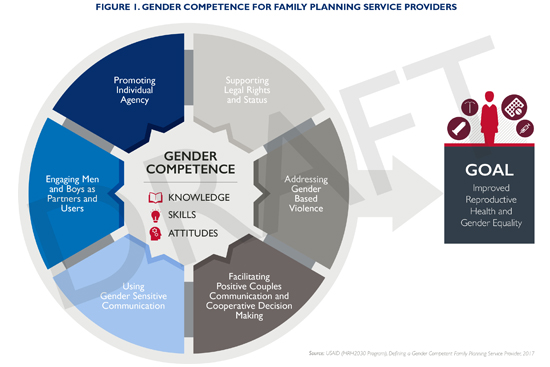Empowering Health Workers to Provide Gender-Competent Family Planning Services

A health worker counsels a client about family planning methods in the Philippines. Photo credit: Chemonics
Samantha Law, Chemonics International and USAID HRH2030
Health workers can be powerful change agents to address equity. We’ve seen frontline workers heroically fight Ebola. We’ve seen them overcome stigma and their own biases to provide quality HIV services. What if we could tap this potential to reduce gender bias in health service delivery? When we consider issues of access to family planning services and supporting reproductive empowerment, the gender competence of the frontline health workers who deliver these services is key to enabling individuals to make informed reproductive health decisions and act on their choices to achieve desired reproductive outcomes.
A health worker often serves as the main interface between community members and their reproductive health decisions. And, decisions about if and when to have children — and how many children to have — are intrinsically tied to gender. To ensure the services she or he provides meet clients’ needs, a health worker must recognize the impact of gender norms, bias, and power. Not doing so can influence the quality and completeness of family planning information and services. For example, does a health worker assume that all young, married women who visit her will want to have children soon and fail to offer them information about long-acting contraceptive methods? Does another health worker miss opportunities to provide his male patients with family planning information because he doesn’t view them as family planning clients?
To help health workers recognize their own gender biases and become gender-competent providers of family planning services, the USAID HRH2030 program has developed a definition of gender competence and created the Gender Competency Framework for Family Planning Service Providers (in press). This framework links gender and family planning service provision by outlining the knowledge, skills, and attitudes health workers need to reduce provider bias. When family planning providers are competent at addressing gender issues in family planning, they can contribute to reproductive empowerment and improve reproductive health and gender equality. Ultimately, we can incorporate these concepts into pre-service education curricula to encourage their development in all health workers.
How does a health worker demonstrate gender competency?
To show what this might look like in action, we can use the example of a nurse manager, named Asha, who is gender competent at a rural clinic. She demonstrates gender competency across six domains in her role over time.
- Using gender-sensitive communication. When an unmarried woman comes seeking family planning information and a method that is right for her, Asha establishes a non-judgmental rapport with her, gives her complete information about method options, and confirms that she understands.
- Promoting individual agency. Asha asks the woman about her family planning needs to ensure she can make an informed and voluntary choice that’s right for her current situation. After time, the woman marries, and Asha supports her changing family planning needs.
- Supporting legal rights and status related to family planning in accordance with rights and local laws. Asha knows that local laws and policies do not require a husband's consent for her client to use family planning. So, after her client makes an informed choice of method, Asha provides her with that method and reinforces what she needs to know about its use.
- Engaging men and boys as partners and users. Asha respectfully asks the woman if she would like her husband to join their session. She then uses affirmative language to encourage positive male participation in method choice and use.
- Facilitating positive couples’ communication and cooperative decision-making. Asha gives equal attention to both the woman and her husband during couples’ counseling and discusses each partner’s concerns and preferences for family planning methods.
- Addressing gender-based violence. Asha regularly assesses her family planning clients for common signs and symptoms of gender-based violence. She has an established rapport with the trained gender-based violence provider and knows how to make a warm and compassionate referral when necessary.

By using the Gender Competency Framework for Family Planning Service Providers, health workers like Asha can improve their gender knowledge, skills, and attitudes. By doing so, they can better respond to the diverse needs of all clients and potential clients, deliver more equitable and high-quality family planning services to a greater number of individuals, couples, and families, and promote clients’ free and informed choice.
As we advance the FP2020 agenda to support the rights of individuals to decide, freely, and for themselves, whether, when, and how many children they want to have, we need to give providers the resources to fully join in. Family planning providers who are gender competent are the next change agents to address equity and reach unmet needs for family planning.
